Zero tolerance
There is no time to waste and even less room for waste for Josh Heptig, the recipient of GCSAA’s 2017 President’s Award for Environmental Stewardship.
Howard Richman
Photos by Tony Hertz
Read this story in GCM's digital edition »
Josh Heptig knows a thing or two about blazing trails.
Entering his freshman year of high school in the small south-central Kansas town of Winfield, Heptig says he could lose weight simply by sitting in the classroom. Who could argue with him? He was rail-thin, a skinny 85 pounds on his 5-foot-7 frame.
“I ate all the time — breakfast, lunch and dinner. I can remember getting up from the table in the evening and heading for the pantry, to my mom’s disbelief,” Heptig says. “I just had an extremely high metabolism.”
Heptig burned calories running high school cross-country and track. His freshman seven-minute mile times didn’t produce accolades, but that would change, fueled by a surge during the final stretch of his secondary education. As a senior, Heptig paced the team to a tie for first in the state cross-country meet (Winfield lost the tiebreaker), and personally, he placed in the top 10.
Heptig’s rise was no stunner to his coach, David Juhlin. “We had a mantra: Hard work, if given time, beats talent. He wasn’t a real big kid, but he certainly was willing to do the hard work,” Juhlin says.
Others will tell you now that Heptig — who is receiving a prestigious GCSAA honor — has hit his professional stride. And it has much to do with being lean and trim.
Heptig, a proponent of zero-waste management, has attracted attention throughout the industry during his time as the GCSAA Class A superintendent and director of golf course operations with San Luis Obispo (Calif.) County Parks & Recreation. He oversees three golf courses: Morro Bay, Chalk Mountain and Dairy Creek. Heptig’s “Zero Waste Park” initiative at Dairy Creek GC, located within the El Chorro Regional Park, opened in 2011. His objective: Reduce consumption, minimize waste, maximize recycling.
“He sees the public good in golf, and that’s cool,” says Nick Franco, the parks director for San Luis Obispo County Parks & Recreation. “For us, the influence he has on the golf course is significant. Golf’s often seen as wasteful, a luxury, and it isn’t. What he is doing can demonstrate golf is as environmentally sensitive as any activity. He has driven that home to a lot of people.”
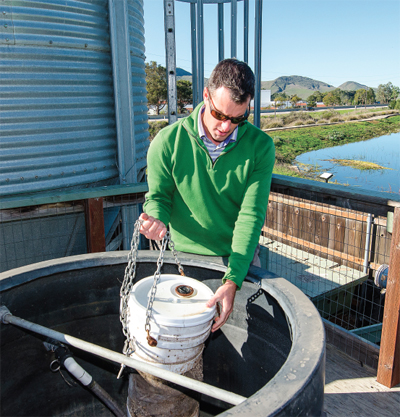
Heptig lifts a “tea bag” made from a modified 5-gallon bucket from his compost tea brewer, with Highway 1 in the background.
Who would have ever thought that a golf course superintendent would be a leader in protecting the environment and reducing food waste? Heptig did. His mission to achieve zero waste features two large composters that replace conventional dumpsters, which means that no food from Dairy Creek contributes to the methane gases escaping from the local landfill. In Heptig’s first three years at Dairy Creek, more than 60,000 pounds of food waste was diverted from rotting in the landfill, and was instead processed into compost.
“He’s a true innovator in the environmental area for golf courses,” says Paul L. Carter, CGCS, director of agronomy at Bear Trace at Harrison Bay (Tenn.) and a 24-year GCSAA member. “The things he’s done out of necessity and desire make him a true asset.”
Now, Heptig’s innovation and passion for the environment have earned recognition from GCSAA, which has named him the 2017 recipient of its President’s Award for Environmental Stewardship. Heptig, 40, will be honored for his achievements Feb. 7 in Orlando during the Golf Industry Show’s Opening Night Celebration, presented in partnership with Syngenta. The award, given since 1991, is based on exceptional environmental contributions to the game of golf — contributions that exemplify the superintendent’s image as a steward of the land.
“This (award) has been a very humbling process. People congratulate me, but sometimes I don’t know how to respond,” says Heptig, a 17-year association member. “There’s a whole lot of other people involved. It’s not just me.”
A beginning
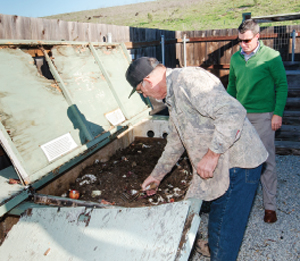 |
|
Heptig and Richard McConaghay tend to the worm bin.
|
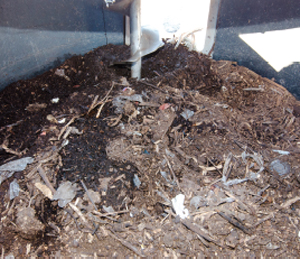 |
|
An inside look at a composter.
|
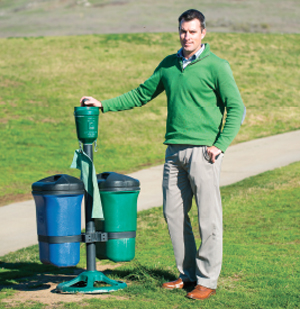 |
|
Heptig takes special pride in the blue recycling bins at Dairy Creek. Per Heptig’s request, Par Aide made the bins in the classic color used to designate recycling.
|
Although he went to Kansas State University in Manhattan with the intention of majoring in pre-veterinary medicine, Heptig was eventually drawn to golf course management.
A native of Topeka, Kan., Heptig spent ample time at his grandfather Charles Elder’s farm (dairy, hogs and row crops) in Wamego, Kan., just a short drive from Manhattan. “There were plenty of places to get dirty. I rode horses and milked cows. I was 6 or 7 when I milked my first cow. I remember thinking it was kind of gross,” he says. His work, however, sustained him. “I still got some milk out of that cow, for sure,” Heptig says.
Heptig was a semester away from graduating with a degree in natural history biology and was pursuing a zoologist position for a zoological park, but the job hunt wasn’t going well. A friend who had introduced him to golf a few years earlier suggested Heptig check out the university’s golf course management curriculum. After some soul searching, Heptig made the switch from the animal kingdom to the plant kingdom, and has never looked back.
The mid-1990s was an opportune time to be at K-State, and not only because legendary football coach Bill Snyder was hitting his stride. Colbert Hills, an 18-hole course named for K-State alum and professional golfer Jim Colbert, was about to be built. The golf industry was booming while Heptig was learning how to manage a nine-hole course in the golf course management program, designed to teach students how to manage in the areas of hospitality, food and beverage, human resources, marketing, accounting and, of course, turf.
In Throckmorton Hall on the K-State campus, Heptig was introduced to the profession of maintaining golf courses and the key role superintendents can play in protecting the environment. In a class taught by Jack Fry, Ph.D., the curriculum included a mock hearing in a conference room. “It was about pesticide use and golf courses, being aware of the issues,” Fry says. “We brought in environmental activists, a lawn-care business owner in Kansas City, someone who was close to what was happening in the legislature, and an older faculty member who was totally against golf courses and everything they stood for.”
Fry even made signs that he placed on the walls, with proclamations such as “Birds Not Birdies!” and “Protect Our Children.” He set aside a minimum two-hour block for the mock hearings. “I think, at first, our students were in shock. It was like, ‘How do we respond to this?’ It opened their eyes a little bit,” Fry says. “I think it probably stuck with him (Heptig) to some degree.”
In fact, it stuck with Heptig a whole lot. “Our class would argue from the turf manager’s perspective — why golf courses should be there and what they could do for a community. Yelling matches ensued, and I thought there might be punches thrown. I realized that a lot of people don’t agree with what golf courses are, and that a lot of people even hate golf courses,” Heptig says. “Many years later, because of that experience and others in my career, I became aware that we (superintendents) need to do something to change that message of what golf can be — and really is already.”
An ace emerges
Heptig made his first hole-in-one shortly after becoming the superintendent at Paragould (Ark.) Country Club. That, however, may have been the least of what he accomplished there.
After graduating from K-State, Heptig bounced around in the field, finding work while his wife, Christiane Schroeter, completed her Ph.D. at Purdue University. At one point, he passed a PGA Playing Ability Test (PAT), and even competed in mini tours while still serving as an assistant superintendent at Coyote Crossing Golf Course in West Lafayette, Ind.
When Schroeter accepted an assistant professor position at Arkansas State University, Heptig was offered the superintendent job at Paragould. The challenges there were many. “Dead grass on 3-year-old putting greens. Fertility and irrigation issues. Building a staff. I was able to use every arrow in my quiver,” Heptig says. “The relationship I was able to build with my membership was invaluable. At first, I think they wondered who they had chosen to care for the course when I core-aerified the greens six times in the first year.”
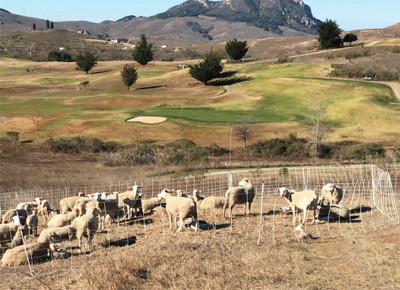
A flock of sheep at Dairy Creek GC last June, with the course’s second green in the background. The course was beginning to turn brown then, as irrigation to fairways and roughs had been turned off for summer.
Randy Bellinger, who owned Coyote Crossing GC when Heptig worked there, says Paragould hired the perfect person to fix the issues. “As an employee, he was great. Hard worker. Highly motivated. Always had an eye on the environmental aspect. Josh always was wanting to learn more and do more and take it to the next level to fulfill his dreams,” Bellinger says.
As he is doing nowadays at Dairy Creek, Heptig created a culture at Paragould. He dabbled in biodiesel technology, trying to transform restaurant oil and grease into fuel for turf equipment. A barn behind his shop was used for recycling, and reclaimed lumber was used to make recycling containers. “We minimized the 55-gallon trash cans throughout the facility and reused them as recycling containers. Members became accustomed to sorting their own waste. Everything we did had a purpose behind it,” Heptig says.
Sheep, worms and butterflies
In the late 1700s, Spaniards settled in San Luis Obispo, a coastal California town halfway between San Francisco and Los Angeles, where strawberries are luscious, soil is rich, and the sun shines more than 300 days a year. In 2007, Heptig and his wife moved to San Luis Obispo, where she is an associate professor in the agribusiness department at California Polytechnic State University.
 |
|
Monarch butterfly clusters at Morro Bay GC, and one of Heptig’s daughters cradling a butterfly.
|
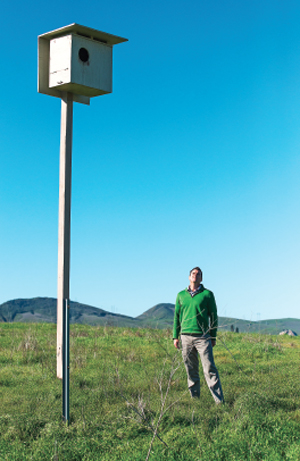 |
|
Heptig observes an owl box at Dairy Creek GC. The owls are part of the integrated pest management program and help control vertebrate pests on the course.
|
When Heptig landed the superintendent position with San Luis Obispo County Parks & Recreation in March 2008, Dairy Creek had no sheep. The golf program was struggling in a recession economy. The one thing that brightened Heptig’s outlook also comforted him. “I had, and still have, an amazingly qualified and well-educated staff,” he says. Soon, they learned that Heptig had big plans for them. For Dairy Creek. And for everyone else — golfers and non-golfers alike.
“Our ultimate goal is to lead by example and help inspire future environmental stewards,” says Heptig, who welcomes tours and gives group presentations at Dairy Creek.
His desire and effort to create a zero-waste golf facility and an environmentally friendly golf facility had a head start. Dairy Creek’s story began with Ray Festa, Heptig’s predecessor, who helped hire him before he retired. “Ray had always done things with the environment in focus. He made sure to protect the land, the staff, and our residents and visitors. He was diligent with paperwork, things such as personnel and plant protection records. I wasn’t scrambling, trying to figure out things on the fly. I had a really good road map with a past history of where we had been,” Heptig says.
He also gained plenty of support, including assistance from EPA Inc., a nonprofit corporation that participated in the planning of Dairy Creek’s Zero Waste Park. The Integrated Waste Management Authority of San Luis Obispo donated two in-vessel composters. The Morro Bay National Estuary Program funded education and outreach. Eco Rotary Club of Morro Bay helped install infrastructure. And, at Heptig’s request, Par Aide began manufacturing recycling bins in blue, the color commonly used to symbolize recycling. “Seeing the blue containers on the GIS showroom floor the next year proved that we are helping to change the culture of golf,” Heptig says.
“Tea time” for Heptig may not be what you think. A compost tea brewer, which makes a product that can be used as a liquid fertilizer and biostimulant, was a full-steam-ahead proposition. In a process known as “vermiculture,” earthworms digest food waste material in what Heptig refers to as their “cold” compost bin (meaning the compost is created through the worms’ digestion of food waste instead of through the traditional bacterial decomposition of food waste, which generates heat). The process continues when the worm compost is used to brew a compost tea that becomes nutrient-rich turfgrass fertilizer.
Birds of prey (16 owl boxes and 40 raptor perches) are part of the integrated pest management program to help control rodents, gophers and other vertebrate pests. As for those sheep, well, they are on the spot to help native plant species return to natural areas and to eliminate invasive plants, all while returning carbon to the soil. This grazing practice eliminates the need for gas-powered equipment or herbicides that may be harmful to the environment or patrons of the facilities. “We’re following in the footsteps of our predecessor, Old Tom Morris. He used sheep,” says Heptig, who recycles everything from egg cartons to milk jugs.
“This is no fly-by-night operation,” says Jeff Jensen, GCSAA’s Southwest regional field staff representative. “He’s got all his stations labeled. It’s a clean operation. It’s a really good image for the golf industry. Josh has a great ability to communicate his vision. His outreach is an important part of the message.”
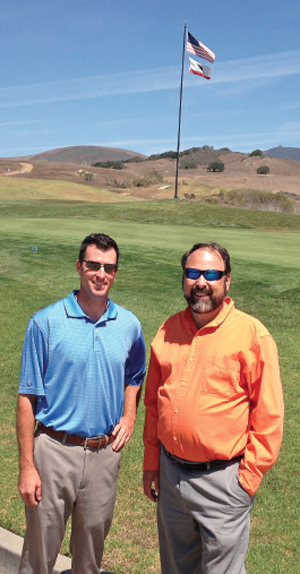
Heptig puts on his Grassroots Ambassador hat, giving Greg Haas (aide to former Rep. Lois Capps) a tour of Dairy Creek GC.
Heptig and his wife have two daughters. His oldest wanted her fifth birthday party to be at Morro Bay GC. Why? Monarch butterflies. Thousands of them (17,000, according to the latest count). “She wanted to play some golf and show her friends the butterflies. They all had a blast,” says Heptig, who’s also thrilled to see the butterflies. “We didn’t choose them — they chose us. When we give tours, people are surprised that the monarchs live on a golf course, because of the negative perception they have about the management of turf. Once I begin to tell them about how we manage Morro Bay, they are amazed about the lengths we go to to protect our natural resources and community. We don’t hide anything, and are upfront with our use of water and chemicals. By the end of the tour, attendees are in awe and agree that we are doing things right if the butterflies choose to live in the middle of our golf course. We let them know that what we are doing is more like the norm in our industry rather than the exception.”
What Heptig has accomplished brings joy to Richard McConaghay. A carpenter and contractor in San Luis Obispo who was a volunteer golf course marshal when he first met Heptig, McConaghay recalls a time when you couldn’t find any recycling containers on the golf course. McConaghay and some friends approached Heptig about being their voice — and muscle — in making environmentally related changes. They had no idea, though, that their relationship would create Dairy Creek’s Zero Waste Park. “Josh has done the hard work. He’s solid,” McConaghay says. “He’s not faking it. He’s chipped away with the truth.”
In college, Heptig stopped running competitively, and, in time, stopped altogether. “Without the competition, I really didn’t have the fire to keep running, plus my passion for the game of golf became a bigger focus,” he says.
Five years ago, however, Heptig started running again — just not in the neon yellow spikes with purple stripes that he wore while emerging as a star in high school. He says his metabolism has slowed with age, and that he runs to remain healthy, not to run competitively. Still, the race to make this a better world continues.
“I don’t know where the finish line is. Just work as hard as you can, and make time for your family,” Heptig says. “In my job, there’s nearly always a solution. My goal right now is to find the best solutions with our community in mind, because our courses belong to them.”
Howard Richman is GCM’s associate editor.